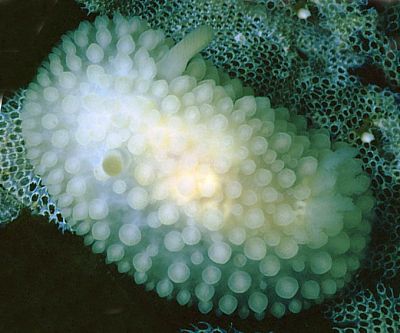
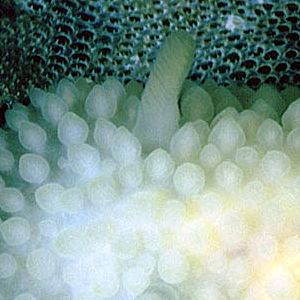
Adalaria proxima
(Alder & Hancock, 1854)
Order: NUDIBRANCHIA
Suborder: DORIDINA
Superfamily: ANADORIDOIDEA
Family: Onchidorididae
DISTRIBUTION
Boreo-Arctic. Nth Atlantic: Known from east Greenland and southwards along the Nth American coast to southern Massachusetts, USA. Common around Iceland, Norway, the Baltic and south to the British Isles. Intertidal to 60m. Nth Pacific: From southern British Columbia, Canada to Sth Korea.
PHOTO
Strangford Lough, Co. Down, Northern Ireland, 28 April 2001. On bryozoan Electra pilosa. Photo: Bernard Picton.
Very similar in shape, colour variation, food and habitat to Onchidoris muricata. It grows to a larger size (17-25mm - compared to 12mm for O. muricata), and the mantle papillae taper to a slender rounded tip while in O. muricata they are flattened with projecting spicules.
It feeds preferentially on Electra pilosa which grows on brown algae, but will eat other encrusting bryozoans if necessary. Both species spawn from February to May (late winter, Spring) so only juveniles are present during Summer months. Differs from O. muricata in having larger eggs which hatch after approx 40 days into lecithotrophic non-feeding planktonic larvae.
-
Bleakney, J.S., (1996) Sea Slugs of Atlantic Canada and the Gulf of Maine
-
Millen, Sandra. (1987) The nudibranch genus Adalaria with a description of a new species from the northeastern Pacific. Canadian Journal of Zoology, 65: 2696-2702
Thompson, T.E. & Brown, G.H. (1984) Biology of Opisthobranch Molluscs, Vol 2. Ray Society: London.
Rudman, W.B., 2001 (July 5) Adalaria proxima (Alder & Hancock, 1854). [In] Sea Slug Forum. Australian Museum, Sydney. Available from http://www.seaslugforum.net/find/adalprox
Related messages
Re: Adalaria proxima egg coils
November 10, 2007
From: J. Hildering & G. Miller

Concerning message #19495:
Thought it might be interesting to see photos suggesting the abundance of Adalaria proxima at this site at this time of year. They appear to be targeting Membranipora serrilamella. The one little string of eggs does not look like theirs.
Locality: Bear C, 40', Pacific Ocean, 29 September 2007, Muddy. Length: 1.5 cm. Photographer: Jackie Hildering.
Jackie Hildering & Glen Miller
earthlingenterprises@telus.net



Hi Jackie and Glen,
Great report. There are a bunch there. Very interesting. Can't comment on the egg ribbon. Not sure whose it is.
Best wishes,
Dave Behrens
Adalaria proxima egg coils
February 20, 2007
From: Jackie Hildering
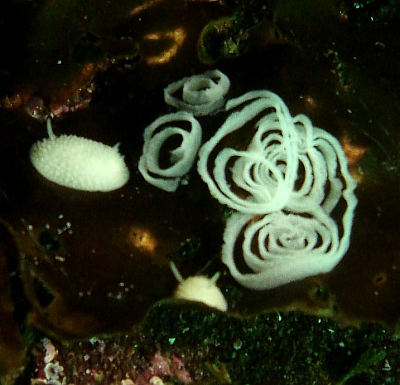
The photos are not ideal but thought it might be of interest to have photos of the egg masses that might potentially allow discerning between Adalaria proxima and Onchidoris muricata. There were multiple patches of Adalaria laying eggs at this site. Do they too have an annual lifecycle like Onchidoris?
Locality: Five Fathom Rock, Port Hardy, 55, British Columbia, Canada, Pacific Ocean, 18 February 2007, Bouldered bottom . Length: 1.5 cm. Photographer: Glen Miller.
Great thanks for your dedication to this site,
Jackie Hildering
econauts@telus.net
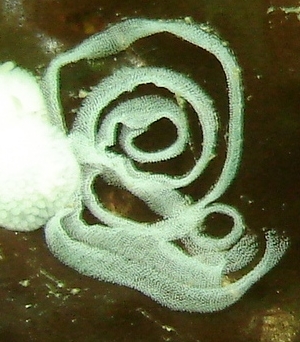
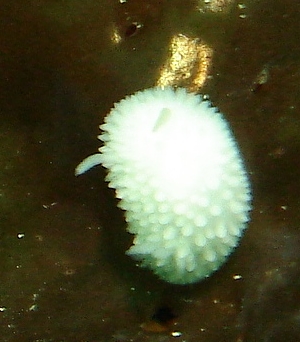
Dear Jackie,
Thanks for the photos. I am surprised we haven't many photos of the egg masses of these two species, which have been the subject of many studies comparing their reproductive strategies, life histories etc. You will find a link to some major references on this work onthe Fact Sheets of both species.
Both have annual life cycles, but Adalaria proxima has lecithotrophic larvae [non-feeding planktonic larvae] while Onchidoris muricata has planktotrophic [feeding planktonic larvae].
Best wishes,
Bill Rudman
Re: Korean Adalaria proxima
February 12, 2006
From: Sandra Millen
Concerning message #15764:
I think this is correctly identified as Adalaria proxima. It has rather inflated tubercles which makes it look a lot like Onchidoris muricata, which has shorter, star-shaped spicules at its base. However, O. muricata tends to have less pointed tubercle tips and the tubercle spicules are more spread out rather than coalescing at the center.
Sandra Millen
millen@zoology.ubc.ca
Millen, S., 2006 (Feb 12) Re: Korean Adalaria proxima. [Message in] Sea Slug Forum. Australian Museum, Sydney. Available from http://www.seaslugforum.net/find/15820Thanks Sandra,
Bill Rudman
Re: Korean Adalaria proxima feeding
February 12, 2006
From: Jeff Goddard
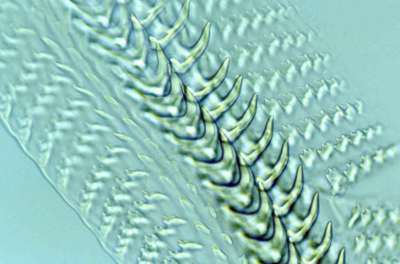
Concerning message #15764:
Hi Bill,
Sandra's the expert and has indeed done dissections confirming the presence of Adalaria proxima in the north Pacific (Millen 1987). Additionally, a few years ago I confirmed the identity of two specimens I collected in 1999 from Prince William Sound, Alaska by examining their radulae. One specimen, 3 mm long preserved, had a radular formula of 30 x 7.1.1.1.7, while the second specimen, 10 mm long preserved (and whose radula is pictured here), had a formula of 36 x 9.1.1.1.9. The arrangement of the spicules in the dorsum and tubercles of both of these specimens was the same as in Dong Bum Koh's specimen from South Korea.
Locality: Cordova, Prince William Sound, Intertidal, Alaska, North Pacific, 13 August 1999, Rock jetty. Length: 10 mm (preserved adult). Photographer: Jeff Goddard
-
Millen, S.V. 1987. The genus Adalaria with a description of a new species from the northeastern Pacific. Canadian Journal of Zoology 65:2696-2702.
Best wishes,
Jeff
goddard@lifesci.ucsb.edu
Goddard, J.H.R., 2006 (Feb 12) Re: Korean Adalaria proxima feeding. [Message in] Sea Slug Forum. Australian Museum, Sydney. Available from http://www.seaslugforum.net/find/15822Thanks Jeff,
Bill Rudman
Korean Adalaria proxima feeding
February 11, 2006
From: Dong Bum Koh
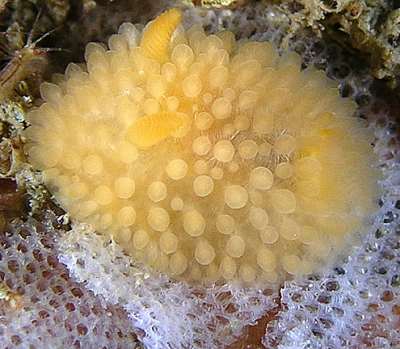
Dear Bill,
Here are photos what I think is Adalaria proxima with its food from South Korea.
Locality: Ul Jin, Gyung Book Prov., Korea, East Sea. Depth: 22 m, Length: Approx. 10 mm. 05 Feb. 2006. with Food(?). Photographer: Ok Soo Kim
Best regards,
Dong Bum Koh
drkoh@seasee.co.kr
D.B.Koh, 2006 (Feb 11) Korean Adalaria proxima feeding. [Message in] Sea Slug Forum. Australian Museum, Sydney. Available from http://www.seaslugforum.net/find/15764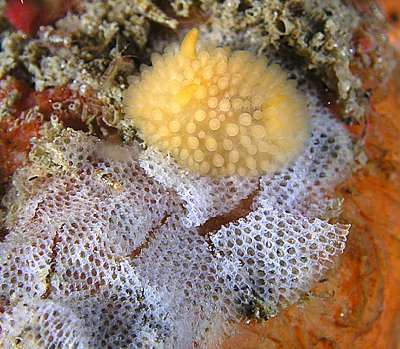
Dear Koh,
Thanks very much for this record. Your animal certainly looks like what is identified in the Nth Pacific as Adalaria proxima but I can't find a reference to anyone actually checking out its anatomy to confirm the identification, If someone has a reference I would be grateful. It certainly has the 'starburst' arrangement of spicules at the base which are considered characteristic of the species. If it is A. proxima, I think this is the first record from Korea. I note that Rie Nakano (2004) records it from Japan.
Perhaps Sandra Millen, who has studied these animals in some detail from the Nth Pacific has a comment to make?
Best wishes,
Bill Rudman
Re: Adalaria proxima? from British Columbia?
October 9, 2003
From: Jeff Goddard
Hi Bill,
I agree with your suggestion that the onchidoridid in Marli Wakeling's recent photo is probably not Onchidoris muricata, based on the shape of the tubercles and the arrangement of the spicules in the center of the notum [in O. muricata the latter are visibly transverse and parallel]. However, assuming that the specimen was found on the substrate pictured (the bryozoan Membranipora), it may well be Adalaria jannae Millen, 1987. I found this species in abundance feeding and laying eggs on Membranipora growing on kelps in south central Alaska a couple of years ago (Goddard & Foster, 2002). At first glance I thought they were Onchidoris muricata, but the radula turned out to lack medial teeth and also had 4 to 6 small marginal teeth per half row. These traits, especially in specimens more than a few millimeters long, separate A. jannae from both O. muricata and A. proxima.
Millen (1987) also reported Adalaria jannae from Membranipora. In hindsight, my own report of Onchidoris muricata on Membranipora in Coos Bay (Goddard, 1998) is probably incorrect and needs confirmation. I did not look at the radula of those specimens, and I would now bet they were actually A. jannae.
• Goddard, J. H. R. (1998) A summary of the prey of nudibranchs from Cape Arago, Oregon. Opisthobranch Newsletter, 24(2): 11-14.
• Goddard, J. H. R. & N. R. Foster (2002) Range extensions of sacoglossan and nudibranch mollusks (Gastropoda: Opisthobranchia) to Alaska. The Veliger 45(4): 331-336.
• Millen, S. V. The nudibranch genus Adalaria, with a description of a new species from the northeastern Pacific. Canadian Journal of Zoology 65(11): 2696-2702.
Best wishes,
Jeff Goddard
goddard@lifesci.ucsb.edu
Goddard, J. H., 2003 (Oct 9) Re: Adalaria proxima? from British Columbia?. [Message in] Sea Slug Forum. Australian Museum, Sydney. Available from http://www.seaslugforum.net/find/11165Thanks Jeff,
I had looked at Sandra Millen's paper, and she said that the spicule pattern on the notum of A. jannae was similar to that of Onchidoris muricata and specifically compares it to A. proxima which she says differs in having a 'star-like pattern of spicules' at the base of the tubercles. A. proxima grows to a much larger size, but that character is only good in identifying a large specimen - Marli's 8mm long animal could be either. I agree that its presence on Membranipora is a point in favour of identifying it as A. jannae, but my understanding is that although A. proxima prefers Electra pilosa it will eat other encrusting bryozoans.
I guess my problem is that without an anatomical examnination, we can't be sure of this animal's identification, so it could probably lead to confusion if I were to move it to a Adalaria jannae page at this stage. If you have photos of this species which have been confirmed anatomically it would be great to add them to the Forum
Best wishes
Bill Rudman
Re: Adalaria proxima? from British Columbia
October 9, 2003
From: Alan Shepard
Bill -
I have to concur with your identification of Marli's white dorid as Adalaria proxima. Not only are the tubercles pointed but as Bleakney points out another telling point is that the large spicule rods embedded in the mantle radiate from the bases of the largest tubercles in a sunburst pattern. In Onchidoris muricata the spicules run transversely along the dorsum densely packed in parallel.
Best wishes,
Alan Shepard
Tolland, CT, USA
alan.chepard@snet.net
Shepard, A., 2003 (Oct 9) Re: Adalaria proxima? from British Columbia. [Message in] Sea Slug Forum. Australian Museum, Sydney. Available from http://www.seaslugforum.net/find/11167Thanks Alan,
Bill Rudman
Adalaria proxima? from British Columbia
October 6, 2003
From: Marli Wakeling
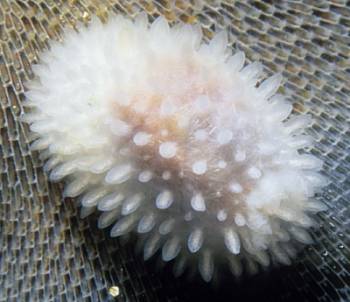
Hi Bill,
Another critter from the shallow bay at God's Pocket, Port Hardy, British Columbia: I believe it may be Onchidoris muricata.
Date: August 2003
Location: God's Pocket Bay, Port Hardy, British Columbia
Depth: 25 feet
Length:8 mm.
Cheers,
Marli Wakeling
scuabamarli@excite.com
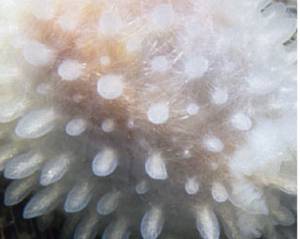
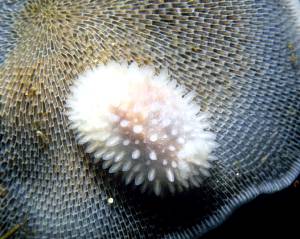
Thanks Marli,
As I have discussed before, some of these tuberculate onchidorids are quite difficult to separate from one another - even ecologists working with live populations sometimes have great difficulties. With that in mind I am somewhat hesistant to disagree with your suggested identification, but the elongate tubercles tapering to a point suggest your animal is not Onchidoris muricata but Adalaria proxima.
Best wishes,
Bill Rudman
Adalaria proxima from Newfoundland
March 23, 2003
From: Paulette Penton
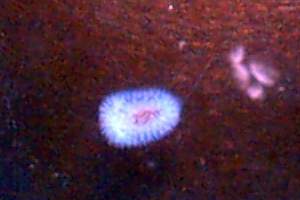
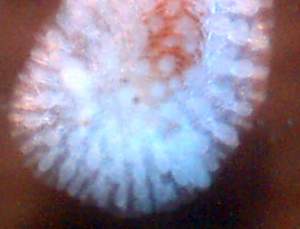
Hey,
I am unfamiliar with Dorids and am assuming that this is one. I only found one individual in my sampling and the identification guides were of no use to my untrained ability. Once again, these pics are horrible quality but it is all that I have. This individual was found at the same site as previously mentioned, on a rock.
was found at my sampling area in Bonne Bay, located in Gros Morne National Park in Newfoundland. It was found in July 2002 at 46' with Obelia on a rocky bottom with big boulders and a wall covered with coralline algae.
Paulette Penton
g84pmp@mun.ca
I think this is either Adalaria proxima or the very similar looking Onchidoris muricata. I tend towards Adalaria because the tubercles seem to taper towards the tip, but as oyu will see on the relevant pages, they are very difficult to separate externally. Both feed on encrusting bryozoans, Adalaria proxima preferring Electra pilosa.
Best wishes,
Bill Rudman
Photos of Adalaria proxima
July 6, 2001
From: Bernard Picton

Dear Bill,
I agree Paul's photos are of Onchidoris muricata and the bryozoan is Membranipora membranacea as you suggested. Here is a photo I took recently of Adalaria proxima on the encrusting bryozoan Electra pilosa.
Details: Strangford Lough, Co. Down, Northern Ireland, 28 April 2001.
Bernard
bernard.picton.um@nics.gov.uk
Picton, B., 2001 (Jul 6) Photos of Adalaria proxima. [Message in] Sea Slug Forum. Australian Museum, Sydney. Available from http://www.seaslugforum.net/find/4781Thanks Bernard,
Onchidoris muricata was decidedly lonely without Adalaria.
Cheers,
Bill Rudman
